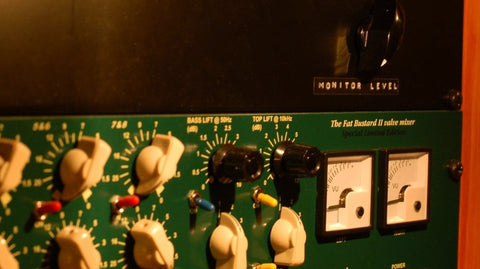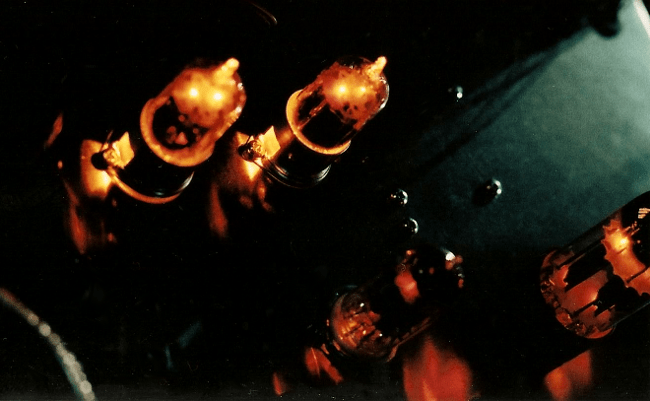Vacuum tubes, also known as thermionic valves, or just valves in the UK, are electronic devices whose operation is based on thermionic emission. This is defined as the emission of electrons from the surface of a solid, in proportion to temperature. The physics of this process concerns the relationship of the thermal energy of the electron with the work function of the material, but in fear of my excitement escalating into a detailed explanation of electron orbits around atomic nuclei, I will skip straight to the plain English account, sparing my readers the lecture.
A heated electrode, called a thermionic cathode, that is placed inside an evacuated glass bulb (a bulb in which the air inside has been removed to create a vacuum) emits plenty of electrons. The number of emitted electrons increases with temperature. The heated cathode then becomes surrounded by a cloud of electrons (a space charge). When a positive potential is applied to a second electrode called the anode within the same glass envelope, the electrons are attracted by the positive potential at the anode and current flows.
(Header image: vacuum tubes glowing in the dark. The glow is produced by the heaters which provide the thermal energy necessary for thermionic emission. Photo courtesy of Agnew Analog Reference Instruments.)
This type of device, containing two elements, the anode and the cathode, functions as a diode. It allows current to flow in one direction only. This type of tube can be used as a rectifier – a device that takes the AC (alternating current) from the wall and converts into the DC (direct current) needed by an audio circuit.
Things get much more interesting if we add another element inside the glass envelope. A grid can be placed between anode and cathode. The electron flow can then be controlled by the grid potential. A negative grid potential with respect to the cathode potential will repel electrons. If it is made sufficiently negative, it will cut off the electron flow. Modulating the grid potential will modulate the electron flow and hence the current through the tube.
In a typical simple tube circuit, a small audio signal fed to the grid of a three-element tube, known as a triode, will modulate the current through the tube (between the anode and the cathode) in proportion to the audio signal. Current flowing through the load connected to the tube will result in a voltage across the load. A small signal voltage at the grid will modulate the current flowing through the load and, given a sufficiently high DC supply to the circuit, the modulation-dependent signal voltage across the load will be much larger than the signal voltage at the grid. A small signal voltage has essentially been converted into a large signal voltage, resulting in amplification!

Unlike the simple diode, tubes with (control) grids like the triode and other tube types (such as tetrodes and those with even more internal elements) are capable of amplification. This development, occurring in 1906 with the invention of the Audion by Lee de Forest, has had a massive impact on our technological progress.
The vacuum tube provided the necessary infrastructure for electrical sound recording and reproduction, the telephone, radio, television and the entire modern era in telecommunications, radar, industrial control and automation systems, medical imaging, computers and all subsequent developments in amplification devices – which form the backbone of pretty much everything we take for granted nowadays.
Early vacuum tubes had very low amplification factors. Gain was at a premium, so if a tube was designed for an application demanding linearity, the tube itself had to be capable of linear operation! These early low-gain vacuum tubes were impractical for use in negative feedback circuits, which sacrifice amplifier gain for error correction. (Without getting too technical, in a negative feedback amplifier part of the circuit’s amplification capability (gain) is used to reduce distortion in the output.
Up until the 1930s some incredibly linear tubes had been created. But they were not cheap, they were not easy to manufacture and they were not exactly energy-efficient.
The tetrode, the pentode and the beam power tube improved on efficiency and manufacturability, but not on linearity. Later triode tubes mostly developed along the same lines. Much higher amplification was becoming available and negative feedback became popular, to electronically compensate for the lack of linearity. This resulted in more complex circuits with a higher component count, but the overall cost was lower as the less-linear tubes were easier to make. (Indeed.)
Then came the transistor (invented in 1947), followed by the solid state operational amplifier (or “op-amp”), housed in a tiny integrated circuit package. Each new invention made things smaller, cheaper and easier to manufacture, with the devices producing less heat and operating more efficiently on lower voltages. Transistors and op-amps ushered in the era of affordable (and disposable) consumer electronics, but were not more linear as devices. (Sound familiar?) Circuits became much more complex, large amounts of negative feedback became the norm in audio circuits and prices went down despite the massive increase in component count in the average audio circuit.
Yet, the 1930s directly-heated triode tubes still remain the most inherently linear devices ever made.
Triodes are inherently linear devices, some types more so than others. The 45 was popular for low power applications. The 2A3 offered a bit more power and the legendary 300B even more, with a single-ended amplifier using one 300B tube producing around 7 W of power at best! This was considered a lot at the time, especially when the 45 triode in a similar single-tube configuration was only capable of a few milliwatts! More power could be obtained with multiple output tubes in parallel single-ended or push-pull configurations, but high-power applications usually required the use of large and expensive transmitting triodes, such as the 211 and the 845, which operated with power supply voltages in the kilovolt range! All of these tube types allow incredibly simple, minimalist circuit configurations, with no need for feedback.
They sound good.
But, as with all the fine pleasures in life, they come at a cost. Having said that, anyone who has ever attempted to wind a grid structure with ultra-fine wire to the level of accuracy and repeatability required in vacuum tube manufacture will never again complain about tube prices.
In fact, once glass blowing, precision machining, exotic materials processing, assembly and all the manufacturing and testing equipment required are all factored in, tubes are pretty reasonably priced. I wouldn’t want to have to make them myself for the prices we can buy them for, in all honesty.
Here’s a video about manufacturing vacuum tubes, from the How It’s Made TV show:
But I also wouldn’t want to have to live without tubes, so I am glad that they are still being manufactured. In fact, some of the 1930s triodes are still being made today and are still being used, both as replacement parts for vintage equipment as well as for new designs! How many other products can really boast continued relevance and desirability over a period of 90 years?
Yes, they are big, heavy, inefficient, produce a lot of heat, require shockingly high voltages, and no university nowadays will teach students how to make them or use them. But they still find applications in a wide range of fields:
There are the audiophiles, who feel that their tube amplifier simply sounds more realistic than anything else. (There are subsets of tube aficionados – those who prefer minimalist designs among them.) I often find myself in agreement, given a well-designed and properly implemented unit.
There are the musicians, especially electric guitar and bass players, who find that nothing else will give them the dynamics and tone of a vintage tube amplifier. It should be noted that the requirements for musical instrument amplifiers are different than for high-fidelity audio systems. The emphasis is not necessarily on linearity, but in the behavior outside the linear region. When tubes are pushed outside their linear region of operation (overdriven), they tend to produce mainly lower-order harmonics, musically and dynamically related to the signal, which tend to sound pleasant. Second harmonic distortion is an octave above the fundamental and third harmonic distortion is a musical fifth above. By comparison, the fifth harmonic is a musical third, but it won’t ask you if you’re playing on a major or minor scale!

Tubes tend to produce mainly second and third harmonic distortion, depending on the circuit configuration and operating level, with higher-order harmonics fading into insignificance. Other amplification devices tend to exhibit the opposite picture: Low second and third harmonics, but predominantly higher-order harmonics. Moreover, tubes have a very gradual transition from “clean” to “distorted” sound.
Tube amps can provide a wide tonal palette, responding to the dynamics of the performer’s playing style. With electric guitar and bass, the tube amplifier is very much an integral part of the instrument, which is why it is customary to record these instruments with a microphone placed near the amplifier’s loudspeaker. Vacuum tube musical instrument amplifiers, both vintage and modern, are sought after by professional musicians and are a regular feature in the world’s most highly regarded recording studios.

There are the recording and mastering engineers, many of whom love the sound of vacuum tube microphone preamplifiers, tube equalizers, tube compressors, and so on. Some of the finest, most transparent and most highly sought after studio equipment is based on vacuum tube electronics. Once again, the very gradual transition from “clean” to “dirty” on a well-designed tube mic preamp works wonders in naturally representing the impressive dynamics of a live performance, where it is generally desired to remain within the linear range. Tubes can offer a huge amount of headroom along with low noise, when carefully selected, resulting in an impressive dynamic range. More “realistic” dynamics result from the very gradual transition from clean to dirty, the predominantly low order harmonics and their “natural” relation to the signal level. This is what makes them sound good in all kinds of signal processing equipment as well. Being known for designing and using all-tube signal paths in the studio, I am obviously in agreement here.


A less obvious but hugely influential supporter of vacuum tube electronics is the military and defense sector. Tubes would survive an EMP (electro-magnetic pulse), whether naturally occurring (such as from lightning, an electrostatic discharge or a solar storm) or as part of an intentional attack. Solid state devices are very sensitive to EMPs and often do not survive such incidents. Mission-critical vacuum tube equipment is therefore still maintained, just in case.
While the military and defense sectors are known for funding and embracing new technologies, they are also famously reluctant to let go of proven, time and field-tested technologies. They also need a regular supply of tubes to keep their old faithful gear going. Considering the circumstances under which military equipment must remain operational, this gives a few hints regarding the reliability and ruggedness potential of a well-made vacuum tube!
Finally, there are medical imaging, transmitter, certain instrumentation and countless other obscure applications, uses and abuses for vacuum tubes in the present day. The vacuum tube manufacturing industry is certainly not what it once used to be. But it is still active, thanks to continued demand. In the recording industry, I have been observing a steadily growing interest in vacuum tubes in recent years. As far as music production, recording and reproduction are concerned, I believe that vacuum tubes will always have their place, regardless of technological developments in other areas.
Less is often more when it comes to sound. At the highest levels of sound quality, things don’t need to be practical or easy. They just need to sound good. As long as vacuum tubes keep on sounding good, they will stay.





